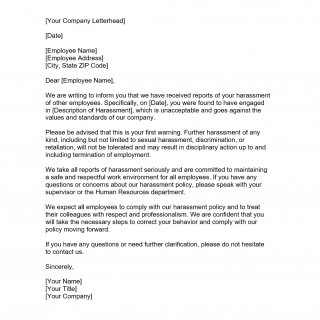Harassment Warning Letter
A Harassment Warning Letter is a formal document used by employers to address an employee's harassment of other employees. The main purpose of this letter is to provide a warning to the employee that further disciplinary action may be taken if the harassment continues.
The letter typically consists of an introduction that identifies the recipient and describes the purpose of the letter. It then provides a detailed description of the harassment, including the date, time, and location of the incident(s), as well as the names of those involved. The letter also includes a warning that further disciplinary action may be taken if the harassment continues, and provides a list of possible consequences.
Important fields to consider when completing the form include the recipient's name and address, the date of the incident(s), and a detailed description of the harassment. It is important to gather as much information as possible when completing the form, including witness statements and any other relevant documentation.
The parties involved in the letter are typically the employer and the employee who has engaged in harassment. It is important to ensure that the recipient of the letter understands the seriousness of the situation and the potential consequences if the harassment continues.
Strengths of this form include its formal and professional tone, which can help to convey the seriousness of the situation. Weaknesses may include its reliance on written documentation, which may not always accurately capture the full scope of the harassment. Opportunities for improvement may include incorporating more interactive or face-to-face communication to better address the issue.
Sample of Harassment Warning Letter
Dear [Employee Name],
We are writing to inform you that we have received reports of your harassment of other employees. Specifically, on [Date], you were found to have engaged in [Description of Harassment], which is unacceptable and goes against the values and standards of our company.
Please be advised that this is your first warning. Further harassment of any kind, including but not limited to sexual harassment, discrimination, or retaliation, will not be tolerated and may result in disciplinary action up to and including termination of employment.
We take all reports of harassment seriously and are committed to maintaining a safe and respectful work environment for all employees. If you have any questions or concerns about our harassment policy, please speak with your supervisor or the Human Resources department.
We expect all employees to comply with our harassment policy and to treat their colleagues with respect and professionalism. We are confident that you will take the necessary steps to correct your behavior and comply with our policy moving forward.
If you have any questions or need further clarification, please do not hesitate to contact us.
Sincerely,
[Your Name]
[Your Title]
[Your Company]
Examples of related and alternative forms may include verbal warnings, mediation sessions, or formal investigations. The main difference between these forms is the level of severity and the potential consequences for the employee.
To fill and submit the form, the employer should gather all relevant information and documentation, and then send the letter via certified mail or hand-deliver it to the employee. A copy of the letter should be kept on file in the employee's personnel record.
In conclusion, a Harassment Warning Letter is an important tool for employers to address harassment in the workplace. By providing a formal warning to the employee, the employer can help to prevent further incidents and maintain a safe and respectful work environment.

